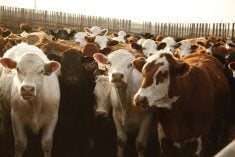Shorthorn cattle are a long-time tradition for Robert Morison’s family at Innisfail, Alta.
And Morison has never been tempted to switch beef breeds.
“Never, never, never,” he said from the Eionmor Shorthorns stall at the Calgary Stampede.
Involved in the business for 65 years, the Morisons have more than 200 Shorthorn cows, ranging in colour from cherry red to roan.
“They’ve always paid the bills. They never have any wrecks,” he said.
Morison led out the grand champion at the Stampede and feels heartened by a resurgence in popularity in these thrifty British cattle.
Read Also

Growth plates are instrumental in shaping a horse’s life
Young horse training plans and workloads must match their skeletal development. Failing to plan around growth plates can create lifelong physical problems.
They produce well-marbled meat and the cows are known for their ample milk production.
Morison sold out of 35 purebred bulls this season.
For Bud and Lil Boake of Acme, Alta., Shorthorns have stood the test of time.
As youngsters, Boake and his brother Bill showed their first Shorthorn calves at the Calgary Stampede in 1933. They were among 30 showmen.
“We stood 29th and 30th,” he said.
Still active in the business, Boake appreciates that the breed has remained moderate-sized and has stayed true to its natural colours of red, roan or white.
“I’ll shoot the person who makes them black,” he joked from his seat at the Stampede show.
Breed outlasted trend
During the 1940s some Shorthorns followed the baby beef trend.
Finished calves of around 800 pounds were in demand at the time. Breeders took steps to shrink the cattle to short-legged, squat animals.
That trend did not last and the pendulum swung back to bigger animals.
“It was easier getting them small than it was getting them big again,” said Lil Boake.
Breeders like Boake and Morison believe these cattle are here for the long term, bucking trends started in the show ring.
The breed originated on the northeastern coast of England in the counties of Northumberland, Durham, York and Lincoln in the 17th century.
It spread to Scotland and then to the United States in 1783, where Shorthorns were called Durham cattle.
Shorthorns arrived in New Brunswick in 1825 and the Canadian department of agriculture started a purebred registry in 1854.
Last year, Canadian livestock records reported that 485 breed members had 675,286 females and 468,627 males registered as purebred.















